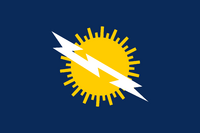United Army of the Liberation
| United Army of the Liberation | |
|---|---|
| လွတ်မြောက်ရေး၏ယူနိုက်တက်ကြည်းတပ် lwatmyawwatrayy eat yuunitetaat kyitaut | |
 | |
| Active | 1964-1971 |
| Allegiance | |
| Type | Pro-Government Paramilitary Force |
| Motto(s) | Land, Sons, Arms! |
The United Army of the Liberation was a pro-Confederal paramilitary group that fought as part of the Royalist Coalition in the Trucial Wars, and was the precursor organisation of the modern Union Defence Force. Beginning as a Labour Battalion mutiny in the former Chauchua Autonomous Tribal Territory, which grew into a Thau-Kin ethnic insurgency against mass conscription by the the People's Republican Army, the UAL proper was formed when the rebels joined forces with Tribal Protection Units from across the United Zomi Councils' border with the Zomi Confederal State, which had been fighting border skirmishes against the PRA for years. Both the Confederal Government and the United Councils claimed the other side had violated the May Ceasefire Agreement of 1962, and their conflict resumed throughout Zomia.
The UAL was the first effective multi-ethnic force fielded against the UZC. Its numbers bolstered by enemy deserters and refugees fleeing agricultural collectivisation, by 1970, the final year of the conflict, it had surpassed the Hsan Salvation Front in size. The ethnic Hsan-Lue militias of the HSF had been the main armed wing of the Royalist Coalition throughout the Trucial Wars, and a destructive rivalry developed between the paramilitaries, clashing with each other as much as the enemy in the race to take the capital.
Fearing a threat to Lue minority rule, Prince-Paramount Hpkeng II Uo Sthe forbade the supplying of arms to the UAL in 1968. Anwra I Na Israt, Sah of Jattasey, and the most powerful princely ally of the Paramountcy, disobeyed the royal sanction, supporting the UAL with less overt forms of aid: vital intelligence on the HSF's operations, and officers of the Trucial Rangers loyal to the Jatt Clan, who provided professional training to UAL militants and co-ordinated their logistics. By the war's end, Anwra I had become the de facto commander of the UAL. When the Hsan Salvation Front's loyalty was called into question by the disastrous Teyvada Crossing Incident of 1971, Hpkeng II ordered its leaders purged, and UAL forces led the arrests. The remaining Union-aligned paramilitaries were consolidated into the Union Defence Force, of which UAL militants loyal to Anwra I constituted the majority. The supremacy of Jattasey over the Paramountcy in Yotkuy was now uncontested, and the position of Viceregnant, the Union's nominally elected head of government, has been held by the Sah of Jattasey to the present day, often considered the power behind the throne.